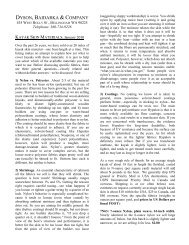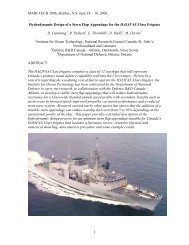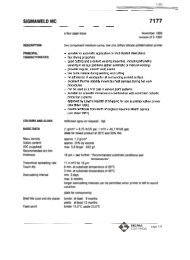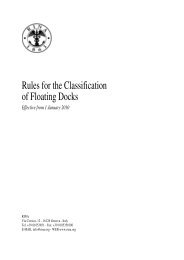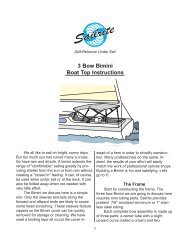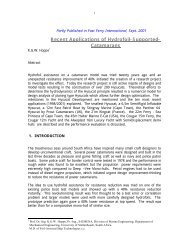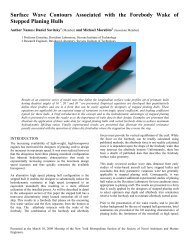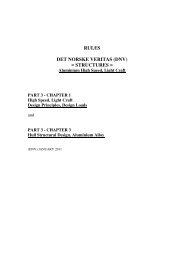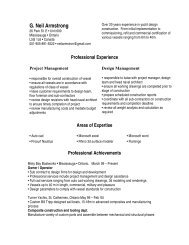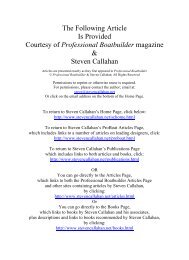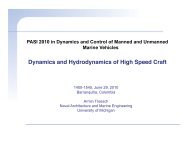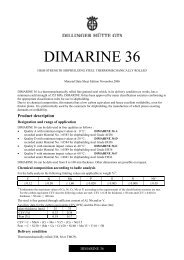SECTION 1 - Boat Design Net
SECTION 1 - Boat Design Net
SECTION 1 - Boat Design Net
Create successful ePaper yourself
Turn your PDF publications into a flip-book with our unique Google optimized e-Paper software.
Pt B, Ch 6, Sec 3<strong>SECTION</strong> 3SPECIFIC GLOBAL LOADS1 General1.1 Application1.1.1 The specific global loads of this Section are applicableto sailing yacht (monohull or catamaran) and to catamarans(sailing yachts or motor yachts).1.1.2 The multihulls with more than two floats are not coveredby the present Section and are to be submitted to aspecial examination.1.1.3 Other requirements may be considered for such specificglobal loads, in case of yachts having unusual particulars.2 Rig loads2.1 General2.1.1 The rig global loadings described in that Section aregenerally to be considered for yachts featuring:• a sailing configuration where mast, stays, shrouds andbackstay induce significant loads in the hull girder• a deck with large openings or significant structural discontinuity• a deck with transverse framing system.2.1.2 The rig global loads inducing a hull girder bendingeffect are to be combined with still water and wave globalloads as indicated in Ch 6, Sec 4.2.1.3 The rig loads to be considered in the present Sectionare the forces induced by the standing rigging:• stays• vertical shrouds and lower shrouds• backstay.The loads induced by the standing rigging during normalnavigation conditions are to be indicated by the Yard and/orby the <strong>Design</strong>er, for the various navigation conditions takingaccount of:• sails reduction versus apparent wind speed• sails configuration for all wind heading from head windto down wind.2.1.4 The combination calculations are carried out withoutany trim and list.2.1.5 The Society reserves the right to determine the rigloads from the sizing of the shrouds. In such case, the forcesare corresponding to the breaking strength of the shroudunder consideration, divided by a coefficient of 2,5 (thiscoefficient is generally the safety factor on breaking strengthused for the design of shrouds in the scantling riggings).The Society may consider a different value for this coefficient,on a case by case basis, upon satisfactory justificationgiven by the Yard and/or the <strong>Design</strong>er.2.2 Sailing monohull with one mast2.2.1 The maximum hull girder bending moment M RIG , inkN.m, induced by the standing rigging, is the mean value offore rig induced hull girder bending moment M RIGF and aftrig induced hull girder bending moment M RIGA , defined asfollows:• where only the forestay is loaded:M RIGF = F E sin α E L E• where only the baby stay is loaded:M RIGF = F BE sin α BE L BE• where both the main stay and the baby stay are loadedsimultaneously:M RIGF = F E sin α E L E + F BE sin α BE L BE• M RIGA = M P + M V1 + M D1where:M P = F P sin α P L PM V1 = F V1 L V1M D1 = F D1 sin α D1 L D1The symbols are shown on Fig 1, where:F P : Load on backstay, in kNF V1 : Load on vertical shroud, in kNF D1 : Load on lower shroud, in kNF E : Load on forestay, in kNF BE : Load on baby stay, in kNα I : Angle from the horizontal, in °, as shown on Fig 1L I : Horizontal distance from mast foot, in m, asshown on Fig 1.2.2.2 The maximum hull girder vertical shear force Q RIG , inkN, induced by the standing rigging, is the mean value offore rig induced hull girder vertical shear force Q RIGF and aftrig induced hull girder vertical shear force Q RIGA , defined asfollows:• where only the main stay is loaded:Q RIGF = F E sin α E• where only the baby stay is loaded:Q RIGF = F BE sin α BE• where both the main stay and the baby stay are loadedsimultaneously:Q RIGF = F E sin α E + F BE sin α BEJuly 2006 with February 2008 Amendments Bureau Veritas Rules for Yachts 125



